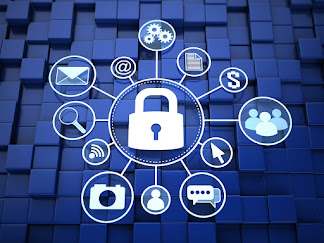CYBERSECURITY - A MUST FOR ALL BUSINESSES
To deal with this topic in depth, we must first answer the following question: by the way, what is cybersecurity? This term was born from "Information security" and relates specifically to the protection of computer information - therefore data. Nowadays, where all things and people are interconnected, security measures are of paramount importance.
What Form Does Cybercrime Take?One danger comes, for example,
from the DarkNet (also called the Deep Web). In this Peer-to-Peer-Overlay
network, the computers are connected manually and directly to each other.
Participants can only join the network by invitation or acceptance. The
exclusivity that such a network offers makes it an ideal meeting place for
cybercriminals, who operate from this network.
Almost every activity,
communication or interaction in cyberspace should be viewed critically. We
briefly present the biggest dangers below:
Viruses are computer programs
that spread on their own and pose a huge risk. They can have an influence on
the hardware, the operating system or other software.
Spam emails are
unwanted emails and are often used for criminal purposes such as spreading
viruses. They also represent a significant risk.
Phishing (or phishing) emails are sent by senders under a false identity in order to gain
access to confidential data. They are among the dangerous emails that should be
deleted immediately.
Trojans are malware and often
cause background damage without the user's knowledge or secretly collect data.
DDOS (Distributed Denial of Service attacks) rely on quantity. This process consists of sending numerous
attacks to an IT service, for example in the form of numerous simultaneous
requests intended to block a service or a website.
Social Engineering is a
telephone combination that uses personal data like a phone number to access
confidential data and use it for personal enrichment. If you are offered an IT
service during a telephone call requiring your access data, it may be this type
of fraudulent call.
Hacking is unauthorized access to
an entire computer or network for the purpose of gaining information or data.
The data can then be used for blackmail purposes, for example.
“WannaCry” malware has
made it possible to lock down data from both private and public computers
around the world and demand a ransom. In Switzerland too, around 200 infections
have been recorded, some of which have caused significant damage. Comprehensive
and regularly updated cybersecurity prevents this type of attack. This example
illustrates only one of the many types of internet crime. Theft of personal or
business data for extortion or sale as well as identity theft are other
examples of cybercrime.
What Weak Points Can Arise And How Can They Be Remedied?
The most frequent weak points
are:
Insufficiently trained employees.
Targeted training can remedy this weak point.
What are called "automation
errors?" such as faulty configurations or insufficient checks of systems
leading to potential security breaches. These loopholes can be remedied by
professional testing methods.
Technologies that do not support
security requirements. Prior to design and implementation, it is a matter of
focusing on precisely “WHAT NEEDS TO BE
PROTECTED, TO WHAT EXTENT, and WITH WHAT TECHNOLOGIES”.
Each company must find a
personalized answer to these questions. There are no one-size-fits-all
solutions. In addition, everyone must keep in mind that cybersecurity is
subject to a certain evolution. It must constantly adapt to changing
technologies to be able to function properly. Keeping the initial configuration
for a long time can quickly become problematic.
Lack of knowledge of the legal
framework. This defect can, however, be easily remedied by regular research.
Thought that "We are too
small and insignificant to fall victim to cybercriminals.” This state of mind
is very widespread, especially in SMEs. This is easily remedied by applying the
motto "Prevention is better than cure". Applying this guideline and
the principle of double checking also helps prevent classic fraud attempts.
It is clear that cyber-attacks
keep increasing. According to a KPMG study, 88% of those surveyed claimed to
have been the victim of a cyberattack in the past year. This corresponds to an
increase of 34% compared to the previous year. A frightening trend that forces
us to act and equip ourselves in terms of cybersecurity.
What Cybersecurity Challenges Can We Expect From Increasing
Digitization?
Thanks to globalization and the
various possibilities offered by the Internet, digitization is spreading at
breakneck speed. So all things and all people can somehow be interconnected,
creating an IoT (Internet of Things). Digital transformation is also bringing
about a profound change in the structure of companies. Workplaces, methods,
employee skills and technologies must adapt to the digital world. As a result,
anyone who has not installed full cybersecurity becomes easy prey.
Businesses should ask themselves the following questions:
Is the choice of technology
relevant?
Is this technology being used and
managed properly?
Is this technology safe enough
for the end customer?
Do employees know how to use
technology properly?
The technologies accompanying
digitization are, for example:
Cloud-computing
It allows the use of the
computing or storage power of remote computer servers via a network.
Big data
In the context of digitization,
big data also presents itself as a challenge. Digital transformation generates
huge amounts of complex data, often insufficiently structured and very
volatile, which can no longer be processed manually. The term “big data” is
used both for these large amounts of data and for the technologies capable of
processing them. The main task is then to properly protect and manage this data
despite its enormous volume.
Mobile work habits (BYOD)
Another important aspect is the
growing need for mobility, which must imperatively be taken into account in the
context of cybersecurity. Today, we work with the most varied mobile terminals,
which also require - or already have - access to the systems of the IT
infrastructure. The taking of security measures regulating access to the
systems and making them transparent is self-evident.
How Can I Protect Myself And My Business?
By a general skeptical attitude
towards the origin of a message and its communication channels on the Internet.
This is a first step towards prevention. Often times, it's out of curiosity or
inattention that we open dangerous emails or mindlessly disclose data to a
questionable address.
By highlighting the potential
risks. Information and training of employees promote vigilance and greatly
reduce application errors.
With a consolidated security
platform. Today, many internet security
infrastructures are very complex, which creates uncertainty in companies
regarding security risks. Technological aspects must be checked and updated
continuously. Regular software updates should be a no-brainer. A suitable IT
security infrastructure, to be continuously checked and updated if necessary,
is the basis for companies.
With an adequate identity and
access management system. It is important to protect access to specific
premises and terminals by means of authentication, for example a password,
certificate or fingerprints. The management of different access systems is the
responsibility of a compliant identity and access management system.




Comments
Post a Comment